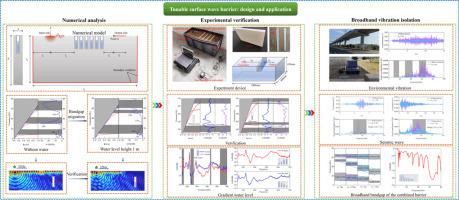Tunable periodic surface wave barriers via water level variation
IF 9.4
1区 工程技术
Q1 ENGINEERING, MECHANICAL
International Journal of Mechanical Sciences
Pub Date : 2025-09-20
DOI:10.1016/j.ijmecsci.2025.110873
引用次数: 0
Abstract
The bandgap characteristics of traditional periodic wave barriers are limited by their fixed geometric shape and material properties, making them difficult to adapt to complex broadband vibration sources that may change at any time. To address this issue, this paper proposes a tunable surface wave periodic vibration isolation barrier based on water level variation. This structure achieves continuous tunability of the bandgap by regulating the water level in the trench, thereby flexibly responding to changes in vibration sources of different frequencies. Using the finite element method, the paper systematically analyzes the mechanism by which water level variation regulate the position and width of the bandgap, and validates its vibration isolation performance through model experiments. The results show that as the water level rises, the bandgap shifts toward lower frequencies. By utilizing the bandgap differences of periodic unit cells with different water levels to construct a broadband vibration isolation barrier, complementary coverage of the bandgap can be effectively achieved. Continuous broadband attenuation is realized in the range of 5.2 Hz to 67.3 Hz, with a maximum displacement attenuation of 40 dB. Further application of this structure to simulate responses to real seismic waves and on-site subway environmental vibrations was conducted. By matching the corresponding variable water level periodic wave barriers to the source frequency, targeted attenuation of the target frequency was achieved. The experimental results showed good consistency with theoretical predictions, verifying the feasibility of the water level-regulated bandgap mechanism in actual engineering applications. This study provides a foundation for constructing efficient, adjustable, and broadbandgap structures.

通过水位变化可调的周期性表面波屏障
传统周期波屏障的带隙特性受到其固定几何形状和材料性质的限制,难以适应随时可能发生变化的复杂宽带振动源。针对这一问题,本文提出了一种基于水位变化的可调谐表面波周期隔振屏障。该结构通过调节沟槽内水位实现带隙的连续可调性,从而灵活响应不同频率振动源的变化。采用有限元方法,系统分析了水位变化调节带隙位置和宽度的机理,并通过模型实验验证了其隔振性能。结果表明,随着水位的升高,带隙向低频偏移。利用不同水位周期晶胞的带隙差异构建宽带隔振屏障,可以有效实现带隙的互补覆盖。在5.2 Hz ~ 67.3 Hz范围内实现宽带连续衰减,最大位移衰减为40 dB。将该结构进一步应用于模拟实际地震波和现场地铁环境振动的响应。通过将相应的变水位周期波障与源频率匹配,实现了目标频率的定向衰减。实验结果与理论预测吻合较好,验证了水位调节带隙机制在实际工程应用中的可行性。该研究为构建高效、可调、宽禁带结构提供了基础。
本文章由计算机程序翻译,如有差异,请以英文原文为准。
求助全文
约1分钟内获得全文
求助全文
来源期刊

International Journal of Mechanical Sciences
工程技术-工程:机械
CiteScore
12.80
自引率
17.80%
发文量
769
审稿时长
19 days
期刊介绍:
The International Journal of Mechanical Sciences (IJMS) serves as a global platform for the publication and dissemination of original research that contributes to a deeper scientific understanding of the fundamental disciplines within mechanical, civil, and material engineering.
The primary focus of IJMS is to showcase innovative and ground-breaking work that utilizes analytical and computational modeling techniques, such as Finite Element Method (FEM), Boundary Element Method (BEM), and mesh-free methods, among others. These modeling methods are applied to diverse fields including rigid-body mechanics (e.g., dynamics, vibration, stability), structural mechanics, metal forming, advanced materials (e.g., metals, composites, cellular, smart) behavior and applications, impact mechanics, strain localization, and other nonlinear effects (e.g., large deflections, plasticity, fracture).
Additionally, IJMS covers the realms of fluid mechanics (both external and internal flows), tribology, thermodynamics, and materials processing. These subjects collectively form the core of the journal's content.
In summary, IJMS provides a prestigious platform for researchers to present their original contributions, shedding light on analytical and computational modeling methods in various areas of mechanical engineering, as well as exploring the behavior and application of advanced materials, fluid mechanics, thermodynamics, and materials processing.
 求助内容:
求助内容: 应助结果提醒方式:
应助结果提醒方式:


